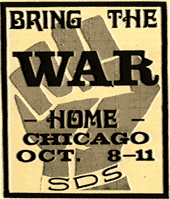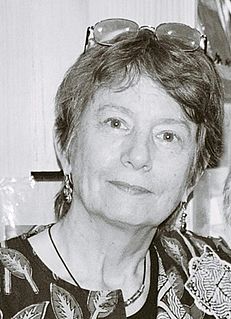Related Research Articles

The Weather Underground Organization (WUO), commonly known as the Weather Underground, was a radical left militant organization active in the late 1960s and 1970s, founded on the Ann Arbor campus of the University of Michigan. It was originally called the Weathermen. The WUO organized in 1969 as a faction of Students for a Democratic Society (SDS) largely composed of the national office leadership of SDS and their supporters. Beginning in 1974, the organization's express political goal was to create a revolutionary party to overthrow American imperialism.
The Seattle Liberation Front, or SLF, was a radical anti-Vietnam War movement, based in Seattle, Washington, in the United States. The group, founded by the University of Washington visiting philosophy professor and political activist Michael Lerner, carried out its protest activities from 1970 to 1971.

Bernardine Rae Dohrn is a retired law professor and a former leader of the radical Weather Underground. As a leader of the Weather Underground in the early 1970s, Dohrn was on the FBI's 10 Most Wanted list for several years. She remained a fugitive, even though she was removed from the list. After coming out of hiding in 1980, Dohrn pleaded guilty to misdemeanor charges of aggravated battery and bail jumping.

The Days of Rage demonstrations were a series of direct actions taken over a course of three days in October 1969 in Chicago, organized by the Weatherman faction of the counterculture-era group Students for a Democratic Society.

Diana Oughton was a member of the Students for a Democratic Society's Michigan Chapter and later, a member of the 1960s radical group Weather Underground. Oughton received her B.A. from Bryn Mawr College. After graduation, Oughton went to Guatemala with the American Friends Service Committee program to teach the young and older indigenous Indians.

Cathlyn Platt Wilkerson, known as Cathy Wilkerson, is an American far-left radical who was a member of the 1970s radical group called the Weather Underground Organization (WUO). She came to the attention of the police when she was leaving the townhouse belonging to her father after it was destroyed by an explosion on March 6, 1970. Members of WUO had been constructing a nail bomb in the basement of the building, intending to use it in an attack on a non-commissioned officers dance at Fort Dix, New Jersey that night. Wilkerson, already free on bail for her involvement in the Chicago "Days of Rage" riots, avoided capture for 10 years. She surrendered in 1980 and pleaded guilty to unlawful possession of dynamite. She was sentenced to up to three years in prison and served 11 months.

Jeff Jones is an environmental activist and consultant in Upstate New York. He was a national officer in Students for a Democratic Society, a founding member of Weatherman, and a leader of the Weather Underground.
Terry Robbins was an American far left activist, a key member of the Ohio Students for a Democratic Society, and one of the three Weathermen who died in the Greenwich Village townhouse explosion.
Naomi Esther Jaffe is a former undergraduate student of Herbert Marcuse and member of the Weather Underground Organization. Jaffe was recently the Executive Director of Holding Our Own, a multiracial foundation for women.

The Greenwich Village townhouse explosion occurred on March 6, 1970, in New York, New York, United States. Members of the Weather Underground (Weathermen), an American leftist paramilitary group, were making bombs in the basement of 18 West 11th Street in the Greenwich Village neighborhood, when one of them exploded. The resulting series of three blasts completely destroyed the four-story townhouse and severely damaged those adjacent to it, including the then home of actor Dustin Hoffman and theater critic Mel Gussow. Three Weathermen—Ted Gold, Diana Oughton and Terry Robbins—were killed in the blast, while two survivors, Kathy Boudin and Cathy Wilkerson, were helped out of the wreckage and subsequently fled.
John Gregory Jacobs was an American student and anti-war activist in the 1960s and early 1970s. He was a leader in both Students for a Democratic Society and the Weatherman group, and an advocate of the use of violent force to overthrow the government of the United States. A fugitive since 1970, he died of melanoma in 1997.
Dianne Marie Donghi is a French former member of Students for a Democratic Society and Weatherman (organization).
Robert Roth was an active member in the anti-war, anti-racism and anti-imperialism movements of the 1960s and 70s, and key member of the Students for a Democratic Society (SDS) political movement in the Columbia University Chapter in New York, where he eventually presided. Later, as a member of the Weatherman/Weather Underground Organization he used militant tactics to oppose the Vietnam War and racism. After the war ended, Roth surfaced from his underground status and has been involved in a variety of social causes to this day.
Howard Norton Machtinger is a former director of Carolina Teaching Fellows, a student teacher scholarship program at the University of North Carolina. He is an education and civil rights activist, a teacher, a forum leader, and a political commentator. Machtinger is a former member of Students For a Democratic Society and Weatherman.
Eleanor E. Raskin was a member of the Weatherman. She is currently an adjunct instructor at Albany Law School. She was an administrative law judge at the New York State Public Service Commission.
Phoebe Hirsch is a former member of Students for a Democratic Society (SDS) and Weatherman (WUO).
The Flint War Council was a series of meetings of the Weather Underground Organization (WUO) and associates in Flint, Michigan, that took place from 27–31 December 1969. During these meetings, the decisions were made for the WUO to go underground, to "engage in guerilla warfare against the U.S. government," and to abolish Students for a Democratic Society (SDS).
The Weather Underground organized collectives around the country in an attempt "to challenge the state directly in solidarity with Third World liberation movements, particularly the Black Power movement here and the Vietnamese in Southeast Asia." Collectives organized the white working class against imperialism by holding militant demonstrations and engaging in small scale property damage.
References
- ↑ Stern, Susan (1975). With the Weathermen: The Personal Journey of a Revolutionary Woman, Doubleday.
- 1 2 3 4 5 Berger, Dan (2006). Outlaws of America, Verso.
- ↑ Short, John G. (12 November 1969). "The Weathermen're Shot, They're Bleeding, They're Running, They're Wiping Stuff Out". The Harvard Crimson (Cambridge).
- 1 2 Jones, Thai (2004). A Radical Line: From the Labor Movement to the Weather Underground, One Family's Century of Conscience, Free Press.
- 1 2 Wilkerson, Cathy (2007). Flying Close to the Sun, Seven Stories Press.
- ↑ Barber, David (2008). A Hard Rain Fell: SDS and Why It Failed, University Press of Mississippi.